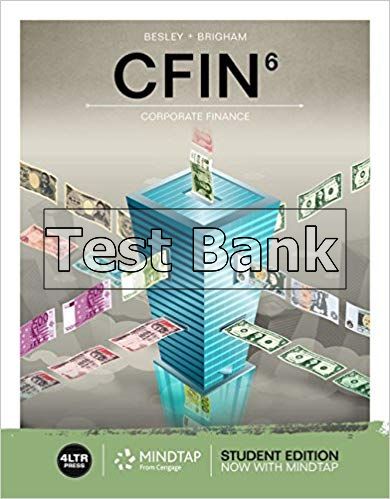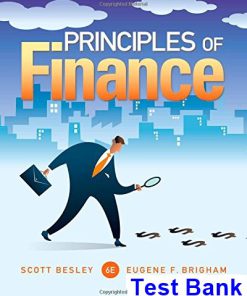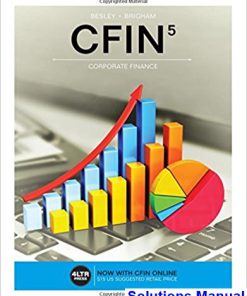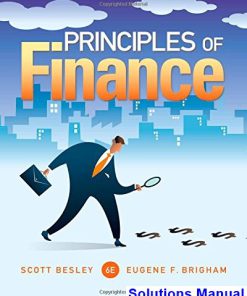$26.50$50.00 (-47%)
In stock
CFIN 6th Edition Besley Test Bank.
You may also like
-
$26.50
$50.00 -
$26.50
$50.00 -
$26.50
$50.00
CFIN 6th Edition Besley Test Bank

Product details:
- ISBN-10 : 1337407348
- ISBN-13 : 978-1337407342
- Author: Dr. Scott Besley
Using your ideal combination of printed text and online resources, learn Corporate Finance YOUR Way with CFIN6! This easy-reference, paperback textbook presents course content through visually engaging chapters as well as Chapter Review Cards that consolidate the best review material into a ready-made study tool. Add in access to assignments and documents from your instructor, and you have everything you need in one place that’s always accessible!
Table contents
Part 1 Introduction to Managerial Finance
1 An Overview of Managerial Finance 2
1-1 What Is Finance? 3
1-1a General Areas of Finance 3
1-1b The Importance of Finance in Non-Finance Areas 4
1-2 Alternative Forms of Business Organization 5
1-2a Proprietorship 6
1-2b Partnership 6
1-2c Corporation 7
1-2d Hybrid Forms of Business: LLP, LLC, and S Corporation 8
1-2e Which Form of Business Is Best? 8
1-3 What Goal(s) Should Business Pursue? 9
1-3a Managerial Actions to Maximize Shareholders Wealth 10
1-3b Should Earnings per Share Be Maximized? 10
1-3c Managers’ Roles as Agents of Stockholders 12
1-4 What Roles Do Ethics and Governance Play in Business Success? 13
1-4a Business Ethics 13
1-4b Corporate Governance 14
1-5 Forms of Business in Other Countries 15
l-5a Multinational Corporations 16
1-5b Multinational Versus Domestic Managerial Finance 17
Key Managerial Finance Concepts 19
Part 2 Essential Concepts in Managerial Finance
2 Analysis of Financial Statements 22
2-1 Financial Reports 23
2-2 Financial Statements 23
2-2a The Balance Sheet 24
2-2b The Income Statement 27
2-2c Statement of Cash Flows 29
2-2d Statement of Retained Earnings 32
2-3 Financial Statement (Ratio) Analysis 32
2-3a Liquidity Ratios 32
2-3b Asset Management Ratios 34
2-3c Debt Management Ratios 35
2-3d Profitability Ratios 37
2-3e Market Value Ratios 37
2-3f Comparative Ratios (Benchmarking) and Trend Analysis 38
2-3g Summary of Ratio Analysis: The DuPont Analysis 38
2-4 Uses and Limitations of Ratio Analysis 39
2-4a Accounting in an International Setting 40
Key Financial Statement Analysis Concepts 42
3 The Financial Environment: Markets, Institutions, and Investment Banking 50
3-1 What Are Financial Markets? 51
3-1a Importance of Financial Markets 51
3-1b Flow of Funds 51
3-1c Market Efficiency 53
3-2 Types of Financial Markets 53
3-2a Stock Markets 55
3-2b Types of General Stock Market Activities 55
3-2c Physical Stock Exchanges 55
3-2d The Over-the-Counter (OTC) Market and NASDAQ 57
3-2e Electronic Communications Networks (ECN) 57
3-2f Competition Among Stock Markets 58
3-2g Regulation of Securities Markets 59
3-3 The Investment Banking Process 59
3-3a Raising Capital: Stage I Decisions 59
3-3b Raising Capital: Stage II Decisions 60
3-3c Raising Capital: Selling Procedures 61
3-4 Financial Intermediaries and Their Roles in Financial Markets 62
3-4a Types of Financial intermediaries 63
3-5 International Financial Markets 65
3-5a Financial Organizations in Other Parts of the World 66
3-5b Recent Legislation of Financial Markets 67
Key Financial Environment Concepts 69
4 Time Value of Money 74
4-1 Cash Flow Patterns 76
4-2 Future Value (FV) 77
4-2a FV of a Lump-Sum Amount-FVn 77
4-2b FV of an Ordinary Annuity- FVAn 79
4-2c FV of an Annuity Due-FVA(DUE)n 79
4-2d FV of an Uneven Cash Flow Stream-FVCFn 80
4-3 Present Value (PV) 81
4-3a PV of a Lump-Sum Amount-PV 82
4-3b PV of an Ordinary Annuity-PVAn 82
4-3c PV of an Annuity Due-PVA(DUE)n 83
4-3d Perpetuities 84
4-3e PV of an Uneven Cash Flow Stream-PVCFn 84
4-3f Comparison of FV with PV-Understanding the Numbers 85
4-4 Solving for Interest Rates (r) and Time (n) 87
4-4a Solving for r 87
4-4b Solving for n 88
4-5 Annual Percentage Rate (APR) and Effective Annual Rate (EAR) 88
4-5a Semiannual and Other Compounding Periods 88
4-5b Comparison of Different Interest Rates 89
4-6 Amortized Loans 91
Key Time Value of Money Concepts 93
Part 3 Valuation-Financial Assets
5 The Cost of Money (Interest Rates) 100
5-1 The Cost of Money 101
5-1a Realized Returns (Yields) 101
5-1b Factors That Affect the Cost of Money 101
5-1c Interest Rate Levels 102
5-2 Determinants of Market Interest Rates 104
5-2a The Nominal, or Quoted, Risk-Free Rate of Interest, TRF 105
5-2b Inflation Premium (IP) 106
5-2c Default Risk Premium (DRP) 106
5-2d Liquidity Premium (LP) 107
5-2e Maturity Risk Premium (MRP) 107
5-3 The Term Structure of Interest Rates 108
5-3a Why Do Yield Curves Differ? 109
5-3b Does the Yield Curve Signal Future Interest Rates? 113
5-4 Other Factors That Influence Interest Rate Levels 114
5-4a Federal Reserve Policy 114
5-4b Federal Deficits 115
5-4c International Business (Foreign Trade Balance) 115
5-4d Business Activity 115
5-5 Interest Rate Levels and Stock Prices 116
5-5a The Cost of Money as a Determinant of Value 116
Key Cost of Money (interest Rate) Concepts 118
6 Bonds (Debt)-Characteristicis and Valuation 124
6-1 Characteristics and Types of Debt 125
6-1a Debt Characteristics 125
6-1b Types of Debt 125
6-1c Short-Term Debt 126
6-1d Long-Term Debt 127
6-1e Bond Contract Features 129
6-1f Foreign Debt Instruments 130
6-2 Bond Ratings 131
6-2a Bond Rating Criteria 131
6-2b Importance of Bond Ratings 132
6-2c Changes in Ratings 132
6-3 Valuation of Bonds 133
6-3a The Basic Bond Valuation Model 133
6-3b Bond Values with Semiannual Compounding 134
6-4 Finding Bond Yields (Market Rates): Yield to Maturity and Yield to Call 134
6-4a Yield to Maturity (YTM) 135
6-4b Yield to Call (YTC) 135
6-5 Interest Rates and Bond Values 136
6-5a Changes in Bond Values over Time 137
6-5b Interest Rate Risk on a Bond 138
6-5c Bond Prices in Recent Years 140
Key Bond Characteristics and Valuation Concepts 143
7 Stocks (Equity)-Characteristics and Valuation 148
7-1 Types of Equity 149
7-1a Preferred Stock 149
7-1b Common Stock 150
7-1c Equity Instruments in International Markets 153
7-2 Stock Valuation-The Dividend Discount Model (DDM) 153
7-2a Expected Dividends as the Basis for Stock Values 154
7-2b Valuing Stocks with Constant, or Normal, Growth (g) 155
7-2c Valuing Stocks with Nonconstant Growth 158
7-3 Other Stock Valuation Methods 161
7-3a Valuation Using P/E Ratios 161
7-3b Evaluating Stocks Using the Economic Value Added Approach 161
7-4 Changes in Stock Prices 162
Key Stock Valuation Concepts 165
8 Risk and Rates of Return 170
8-1 Defining and Measuring Risk 171
8-1a Probability Distributions 171
8-2 Expected Rate of Return 172
8-2a Measuring Total (Stand-Alone) Risk: The Standard Deviation (σ) 172
8-2b Coefficient of Variation (Risk/Return Ratio) 174
8-2c Risk Aversion and Required Returns 174
8-3 Portfolio Risk-Holding Combinations of Investments 176
8-3a Firm-Specific Risk Versus Market Risk 179
8-3b The Concept of Beta 180
8-3c Portfolio Beta Coefficients 182
8-4 The Relationship Between Risk and Rates of Return: The CAPM 183
8-4a The Impact of Inflation 185
8-4b Changes in Risk Aversion 185
8-4c Changes in a Stock’s Beta Coefficient 186
8-4d A Word of Caution 186
8-5 Stock Market Equilibrium 186
8-6 Different Types of Risk 187
Key Risk and Return Concepts 190
Part 4 Valuation-Real Assets (Capital Budgeting)
9 Capital Budgeting Techniques 196
9-1 Importance of Capital Budgeting 197
9-1a Generating Ideas for Capital Projects 198
9-1b Project Classifications 198
9-1c The Post-Audit 199
9-2 Evaluating Capital Budgeting Projects 199
9-2a Net Present Value (NPV) 200
9-2b Internal Rate of Return (IRR) 202
9-3 Comparison of the NPV and IRR Methods 203
9-3a NPVs and Required Rates of Return-NPV Profiles 204
9-3b Independent Projects 204
9-3c Mutually Exclusive Projects 205
9-3d Cash Flow Patterns and Multiple IRRs 206
9-4 Modified internal Rate of Return 207
9-5 Use of Capital Budgeting Techniques in Practice 208
9-5a Payback Period:Traditional (Nondiscounted) and Discounted 209
9-5b Conclusions on the Capital Budgeting Decision Methods 211
9-5c Capital Budgeting Methods Used in Practice 212
Key Capital Budgeting Concepts 214
10 Project Cash Flows and Risk 220
10-1 Cash Flow Estimation 221
10-1a Relevant Cash Flows 221
10-1b Incremental (Marginal) Cash Flows 223
10-1c Identifying Incremental Cash Flows 224
10-2 Capital Budgeting Project Evaluation 226
10-2a Expansion Projects 226
10-2b Replacement Analysis 229
10-3 Incorporating Risk in Capital Budgeting Analysis 232
10-3a Stand-Alone Risk 233
10-3b Corporate (Within-Firm) Risk 236
10-3c Beta (Market) Risk 237
10-3d Project Risk Conclusions 238
10-3e How Project Risk Is Considered in Capital Budgeting Decisions 238
10-4 Multinational Capital Budgeting 239
Key Concepts About Project Cash Flows and Risk 241
Part 5 Cost of Capital and Capital Structure Concepts
11 The Cost of Capital 252
11-1 Component Costs of Capital 253
11-1a Cost of Debt, rdT 254
11-1b Cost of Preferred Stock, rps 255
11-1c Cost of Retained Earnings (Internal Equity), rs 255
11-1d Cost of Newly Issued Common Stock (External Equity), re 258
11-2 Weighted Average Cost of Capital (WACC) 259
11-2a Determining WACC 259
11-2b The Marginal Cost of Capital (MCC) 260
11-2c The MCC Schedule 261
11-2d Other Breaks in the MCC Schedule 263
11-3 Combining the MCC and Investment Opportunity Schedules (IOS) 266
11-4 WACC Versus Required Rate of Return of Investors 267
Key Cost of Capital Concepts 271
12 Capital Structure 278
12-1 The Target Capital Structure 279
12-1a Business Risk 280
12-1b Financial Risk 280
12-2 Determining the Optimal Capital Structure 281
12-2a EPS Analysis of the Effects of Financial Leverage 282
12-2b EBIT/EPS Examination of Financial Leverage 285
12-2c The Effect of Capital Structure on Stock Prices and the Cost of Capital 286
12-3 Degree of Leverage 288
12-3a Degree of Operating Leverage (DOL) 288
12-3b Degree of Financial Leverage (DFL) 290
12-3c Degree of Total Leverage (DTL) 291
12-4 Liquidity and Capital Structure 292
12-5 Capital Structure Theory 293
12-5a Trade-Off Theory 293
12-5b Signaling Theory 294
12-6 Variations in Capital Structures Among Firms 295
12-6a Capital Structures Around the World 296
Key Capital Structure Concepts 298
13 Distribution of Retained Earnings: Dividends and Stock Repurchases 306
13-1 Dividend Policy and Stock Value 307
13-1a Information Content, or Signaling 308
13-1b Clientele Effect 308
13-1c Free Cash Flow Hypothesis 309
13-2 Dividend Payments in Practice 309
13-2a Residual Dividend Policy 309
13-2b Stable, Predictable Dividends 311
13-2c Constant Payout Ratio 312
13-2d Low Regular Dividend Plus Extras 312
13-2e Application of the Different Types of Dividend Payments: An Illustration 313
13-2f Payment Procedures 313
13-2g Dividend Reinvestment Plans (DRIPs) 315
13-3 Factors Influencing Dividend Policy 315
13-4 Stock Dividends and Stock Splits 316
13-4a Stock Splits 316
13-4b Stock Dividends 317
13-4c Price Effects of Stock Splits and Stock Dividends 317
13-4d Balance Sheet Effects of Stock Splits and Stock Dividends 317
13-5 Stock Repurchases 319
13-5a Advantages and Disadvantages of Stock Repurchases 319
13-6 Dividend Policies Around the World 320
Key Distribution of Retained Earnings Concepts 322
Part 6 Working Capital Management
14 Managing Short-Term Financing (Liabilities) 328
14-1 Working Capital 329
14-2 The Cash Conversion Cycle 330
14-3 Current Asset (Working Capital) Financing Policies 333
14-4 Sources of Short-Term Financing 334
14-4a Accruals 335
14-4b Accounts Payable (Trade Credit) 335
14-4c Short-Term Bank Loans 335
14-4d Commercial Paper 336
14-4e Secured Loans 336
14-5 Computing the Cost of Short-Term Credit 337
14-5a Computing the Cost of Trade Credit (Accounts Payable) 338
14-5b Computing the Cost of Bank Loans 338
14-5c Computing the Cost of Commercial Paper 340
14-5d Borrowed (Principal) Amount Versus Required (Needed) Amount 340
14-6 Multinational Working Capital Management 343
Key Concepts for Managing Short-Term Financing 344
15 Managing Short-Term Assets 350
15-1 Alternative Current Asset Investment Policies 351
15-2 Cash Management 352
15-2a The Cash Budget 352
15-2b Cash Management Techniques 356
15-2c Acceleration of Receipts 357
15-2d Disbursement Control 357
15-3 Marketable Securities 358
15-4 Credit Management 358
15-4a Credit Policy 359
15-4b Receivables Monitoring 359
15-4c Analyzing Proposed Changes in Credit Policy 360
15-5 Inventory Management 363
15-5a Types of Inventory 363
15-5b Optimal Inventory Level 363
15-5c Inventory Control Systems 366
15-6 Multinational Working Capital Management 367
15-6a Cash Management 367
15-6b Credit Management 367
15-6c Inventory Management 368
Key Concepts for Managing Short-Term Assets 369
Part 7 Strategic Planning and Financing Decisions
16 Financial Planning and Control 376
16-1 Projected (Pro Forma) Financial Statements 377
16-1a Step 1: Forecast the Income Statement 377
16-1b Step 2: Forecast the Balance Sheet 379
16-1c Step 3: Raising the Additional Funds Needed 380
16-1d Step 4: Accounting for Financing Feedbacks 380
16-1e Analysis of the Forecast 382
16-2 Other Considerations in Forecasting 383
16-2a Excess Capacity 383
16-2b Economies of Scale 383
16-2c Lumpy Assets 383 16-3 Financial Control-Budgeting and Leverage 384
16-3 Financial Control-Budgeting and Leverage 384
16-3a Operating Breakeven Analysis 384
16-3b Operating Leverage 387
16-3c Financial Breakeven Analysis 389
16-3d Financial Leverage 391
16-3e Combining Operating and Financial Leverage-Degree of Total Leverage (DTL) 392
16-4 Using Leverage and Forecasting for Control 393
Key Financial Planning and Control Concepts 395
Appendix A Using Spreadsheets to Solve Financial Problems 403
A-1 Setting Up Mathematical Relationships 403
A-2 Solving Time Value of Money (TVM) Problems Using Preprogrammed Spreadsheet Functions 404
A-2a Solving for Future Value (FV): Lump-Sum Amount and Annuity 405
A-2b Solving for Present Value (PV): Lump-Sum Amount and Annuity 407
A-2c Solving for r: Lump-Sum Amount and Annuity 408
A-2d Solving for n: Lump-Sum Amount and Annuity 408
A-2e Solving for Present Value and Future Value: Uneven Cash Flows 409
A-2f Setting Up an Amortization Schedule 410
Appendix B Solutions to Practice Problems 413
Index 443
People also search:
cfin 6th edition pdf free
d 6 conference
fin episode 6 house of the dragon
fin episode 6 fear the walking dead
what is e in 1e+6












